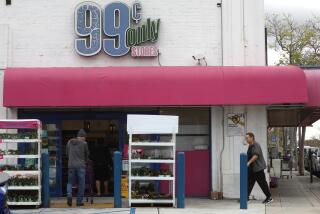Has Electronics Retailer Become a Best Buy Again?
- Share via
Do investors view electronics retailer Best Buy Co. as, well, the best buy they once did?
Between 1996 and mid-2000 the stock of this rapidly growing company soared by an astonishing 28-fold, and Best Buy became as popular an investment in the retail sector as bellwethers Wal-Mart Stores Inc. and Home Depot Inc.
That’s changed in recent months. Best Buy’s stock has tumbled 32% since mid-July, when it reached $80 a share. But the stock has begun rebounding again on the eve of the crucial holiday-shopping season, with bargain-hunting bulls overpowering the bears’ fear that the factors that led to Best Buy’s pullback this year could keep a lid on the stock.
Best Buy jumped another $4.63 a share Thursday, to $54.38, in New York Stock Exchange composite trading after Wal-Mart and some other retailers posted October sales that met Wall Street’s expectations. Sales of electronics were especially robust, boding well for Best Buy. (Best Buy itself does not report monthly sales.)
By most accounts, it’s not Best Buy’s management or the Minneapolis-based company’s execution that were at fault for the stock’s retreat in recent months. Rather, several other events convinced Wall Street that Best Buy no longer deserved the premium price it once enjoyed.
Those events included a slowdown in consumer spending, problems at rival Circuit City Stores, investors’ disenchantment with retail stocks generally, news that supplies of Sony Corp.’s much-awaited video-game player PlayStation 2 would be limited, and the fact that Best Buy’s sales and stock price had run up so high so fast.
“The stock was overextended,” said Donald Trott, an analyst at the brokerage Jefferies & Co. in New York, noting that Best Buy traded for a mere $3 a share in early 1997 after adjusting for subsequent splits. “When you have that kind of run-up, you’re going to have some kind of pullback.”
Indeed, Best Buy’s stock now sells for a moderate 25 times the earnings per share that the company is expected to report for its fiscal year ending Feb. 1. That’s down from a price-to-earnings multiple that exceeded 35 late last year.
There’s no question that Best Buy’s sales growth is slowing as the chain--which now has 401 stores in 41 states, including 44 in California--keeps expanding and consumer spending tails off.
“Consumers are much more cautious amid all of the things that they’re reading about in the economy,” including higher gasoline prices, a volatile stock market and a recent wave of quarterly earnings disappointments from companies of all stripes, said Susan Hoff, Best Buy’s head of investor relations.
Best Buy’s same-store sales--that is, sales at stores open at least a year, and retailing’s main gauge of success--are growing at a slower rate. In its fourth quarter of fiscal 2000 (which includes Christmas), Best Buy’s same-store sales jumped 11.1% from a year earlier, but Best Buy executives are predicting gains of less than half that for the next few months.
One factor in that slowdown is a drop in sales of major appliances. Also, “fears about a slowdown in PC demand appear to have hurt the group recently, following preannouncements [of shortfalls] from Apple and Intel,” Morgan Stanley Dean Witter analyst Susan Quilty said in a recent bulletin to clients.
Best Buy’s cause also wasn’t helped a couple of weeks ago when Circuit City cut its profit outlook for the third time this year, and raised doubts about its holiday-sales prospects.
Investors punished both stocks on that news, but analysts quickly said Circuit City’s problems included factors unique to that company, including costs related to Circuit City’s massive effort to remodel its stores, along with fierce competition from Best Buy, Wal-Mart and Costco Wholesale Corp.
Best Buy “is likely to continue to gain digital [products] market share while [Circuit City] is partially distracted by its efforts to reinvent itself,” analyst Peter Caruso of Merrill Lynch & Co. said in a recent report. “It’s apparent that only the continued softness in consumer spending is likely having an impact on Best Buy’s sales.”
In fact, one of Best Buy’s top strengths is its increased sales of cutting-edge electronic gadgetry, because it’s enjoying strong demand for DVD players and movie titles, digital cameras, camcorders and satellite-based televisions.
Those products “continue to be very popular as more consumers are understanding how to use them and to integrate them with other things they own, like computers and televisions,” said Best Buy’s Hoff. Moreover, those new gadgets typically carry fatter profit margins than older electronics commodities, boosting Best Buy’s bottom line.
That’s why Jefferies’ Trott calls Best Buy a blend of “new economy and old economy,” because it’s a conventional bricks-and-mortar retailer that’s “also a major distributive channel for all the new products coming out of the digital consumer-electronics revolution.”
And despite its slowdown in same-store sales gains, there’s been no letdown in Best Buy’s earnings growth recently. In its fiscal second quarter ended Aug. 26, the company’s profit surged 32% from a year earlier--to $77 million on sales of $3.2 billion--handily beating Wall Street’s forecasts yet again.
For its fiscal year 2001, Wall Street expects Best Buy’s profit to jump 31%, to $2.14 per share from $1.63 in fiscal 2000.
* SALES SLUMP
The nation’s largest retailers reported generally disappointing sales results for October. C5
(BEGIN TEXT OF INFOBOX / INFOGRAPHIC)
Still a Power Outlet
Best Buy Co.’s once-highflying stock has faltered in recent months, partly because consumer spending is tailing off. Chart shows the electronics retailer’s “same-store” sales, or sales at stores open at least a year, are showing smaller gains.
*
2002 1st qtr. estimate: 5%
*
Source: Prudential Securities
More to Read
Inside the business of entertainment
The Wide Shot brings you news, analysis and insights on everything from streaming wars to production — and what it all means for the future.
You may occasionally receive promotional content from the Los Angeles Times.











